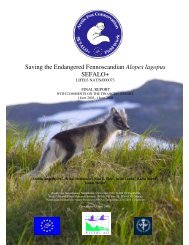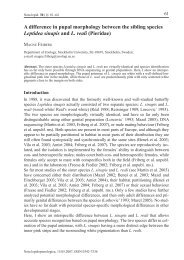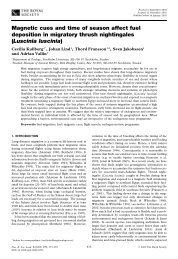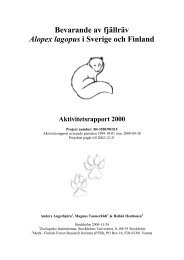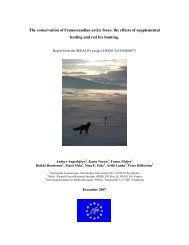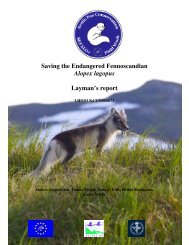Janz et al. 2001
Janz et al. 2001
Janz et al. 2001
You also want an ePaper? Increase the reach of your titles
YUMPU automatically turns print PDFs into web optimized ePapers that Google loves.
EVOLUTIONARY DYNAMICS OF SPECIALIZATION791TABLE 4.Number of plant colonizations leading to host range expansions and host shifts.ExpansionsShiftsP ( 2 )Actu<strong>al</strong> host use 1ACCTRAN 3 DELTRAN 4 Potenti<strong>al</strong> host use 22450.001 (12.44)3430.001 (25.97)1Literature data only.2Data matrix extended with results of the larv<strong>al</strong> establishment test.3Accelerated transformations: equivoc<strong>al</strong> tracings resolved as to accelerate changes.4Delayed transformations: equivoc<strong>al</strong> tracings resolved as to delay changes.ACCTRAN 3 DELTRAN 42630.001 (18.24)3230.001 (24.03)Hypolimnas. The widespread capacity to feed on Urtica wasastonishing, considering that successful establishments wererather rare, and suggests that ancestr<strong>al</strong> host associationssom<strong>et</strong>imes can be r<strong>et</strong>ained for long periods of time as partof the larv<strong>al</strong> repertoire.Although association with Urtic<strong>al</strong>es is a strong conservativefeature, the optimizations of host-plant use show avery dynamic pattern, with a large amount of colonizationsof a h<strong>et</strong>erogeneous group of plants. Even if gains of plantfamilies are weighted twice as high as losses, the optimizationsuggests numerous colonizations and losses of the plant familiesused in the tribe. In tot<strong>al</strong>, there were b<strong>et</strong>ween 23 and37 independent colonizations of 12 plant families within thisclade of 30 butterfly species, depending on weighting scheme(Table 3). Moreover, the vast majority of these colonizationshave occurred within the two genera Nymph<strong>al</strong>is and Polygonia(Fig. 2). This seemingly opportunistic pattern of hostuse is intriguing. Such a high rate of colonization as seenhere would lead to a tremendous diversification in host-plantuse over time, som<strong>et</strong>hing that that is not reflected at <strong>al</strong>l inhigher-level studies (e.g., Ehrlich and Raven 1964; Jermy1984; <strong>Janz</strong> and Nylin 1998), where conservatism in host useis very strong.However, there are reasons to believe that many of thehost-plant colonizations within the clade are not truly independent.A majority of the gains and losses involved the sames<strong>et</strong> of plant families. There were 29–37 independent colonizationsin the datas<strong>et</strong> with actu<strong>al</strong> host use and equ<strong>al</strong> weighting.Of these, 11–17 colonizations involved plants in Urtic<strong>al</strong>es(Urticaceae, Ulmaceae, and Cannabidaceae) and another13–15 colonizations involved the other typic<strong>al</strong> hosts ofNymph<strong>al</strong>is and Polygonia (S<strong>al</strong>icaceae, B<strong>et</strong>ulaceae, Grossulariaceae,Ericaceae, and Rosaceae). Most of these plant familiesare colonized repeatedly, and tog<strong>et</strong>her these eight familiesappear to have been colonized 24–32 times in the Nymph<strong>al</strong>is-Polygoniaclade (including <strong>al</strong>so Roddia and Kaniska).Moreover, there was a bias among successful larv<strong>al</strong> establishmentson nonhosts toward plants used by other butterfliesin the clade (Table 2), <strong>al</strong>so hinting at nonindependence b<strong>et</strong>weenthese colonization events.Interestingly, the few examples of extreme host shifts inthe clade (the use of Smilacaceae by Kaniska canace, Rhamnaceaeby Nymph<strong>al</strong>is c<strong>al</strong>ifornica, and sever<strong>al</strong> novel plant familiesin Cynthia cardui) have <strong>al</strong>l taken place in the most polyphagoussections of the tribe. Oviposition mistakes are wellknown to occur among egg-laying insects (e.g., Chew 1977;Feldman and Haber 1998) and have been argued to providea path to novel plant associations (Larsson and Ekbom 1995).The task of correctly ev<strong>al</strong>uating and discriminating b<strong>et</strong>weenpossible host plants will be increasingly difficult as the hostrange increases (e.g., Bernays 1996, 1998), and polyphagousinsects have been shown to make more oviposition errorsthan speci<strong>al</strong>ists do (Stanton 1984; <strong>Janz</strong> and Nylin 1997; Nylin<strong>et</strong> <strong>al</strong>. 2000). Thus, by increasing the oviposition error rate,polyphagy may facilitate radic<strong>al</strong> host shifts.As expected, doubling the weights of gains over lossesreduced the number of independent colonizations. However,many plant families are still optimized as being colonizedsever<strong>al</strong> times in the clade. One example is Grossulariaceae,which is not used at <strong>al</strong>l in the Nymph<strong>al</strong>id clades close toNymph<strong>al</strong>ini (e.g., Melitaeini, K<strong>al</strong>limini, and Coloburini), indeedit is hardly used at <strong>al</strong>l by butterflies outside of Polygonia.Y<strong>et</strong>, this plant group has been colonized twice within Polygonia,according to the optimizations. At closer inspection,it turns out that there are indications of use of this plantgroup in sever<strong>al</strong> other species in the Nymph<strong>al</strong>is-Polygoniagroup: One note claims that ‘‘N. vau-<strong>al</strong>bum’’ (Roddia l-<strong>al</strong>bum)uses Ribes in eastern Europe (König and Niculescu1970), N. polychloros showed a limited ability to feed onthese plants in our tests (Table 1), and older larvae of P.interrogationis and P. comma are able to feed on Ribes (S.Nylin, pers. obs.). Under these circumstances, it does notseem likely that there have been sever<strong>al</strong> wholly independentcolonizations of this unusu<strong>al</strong> plant family within Polygonia,even though this is what <strong>al</strong>l optimizations suggest. Assumingthat the phylogen<strong>et</strong>ic reconstruction is correct (trees that reduc<strong>et</strong>he number of colonizations of this group to one areabout 10 steps longer) there are three other possible explanationsthat seem more likely: (1) some other shared characteristicof this genus (or possibly the Nymph<strong>al</strong>is-Polygoniaclade) has preadapted them to colonizing Grossulariaceae,that is, a case of par<strong>al</strong>lel evolution (Fig. 4A); (2) an earlycolonization of the family has been followed by sever<strong>al</strong> losses,leaving two disparate sections of Polygonia with this hostplantassociation today (Fig. 4B); and (3) an early associationwith Grossulariaceae may have been lost by one of the Polygoniasections and then recolonized by some of its members(Fig. 4C). These scenarios would neatly explain the gener<strong>al</strong>dynamics of host use in Nymph<strong>al</strong>ini, with much apparentcolonization of shared host-plant families. Larv<strong>al</strong> establishmenttests, tog<strong>et</strong>her with optimizations of actu<strong>al</strong> versus potenti<strong>al</strong>host-plant use, could potenti<strong>al</strong>ly provide evidence forthese scenarios, and, with enough d<strong>et</strong>ail, help choose amongthem (cf., Scriber 1988; Futuyma <strong>et</strong> <strong>al</strong>. 1993, 1994). Unfortunately,our limited samples did not <strong>al</strong>low us to answer thesequestions with any certainty. In addition, the positive results





